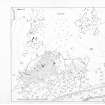Learable Hill
Cup And Ring Marked Stone (Neolithic) - (Bronze Age)
Site Name Learable Hill
Classification Cup And Ring Marked Stone (Neolithic) - (Bronze Age)
Canmore ID 6717
Site Number NC82SE 5
NGR NC 89456 24025
Datum OSGB36 - NGR
Permalink http://canmore.org.uk/site/6717
- Council Highland
- Parish Kildonan
- Former Region Highland
- Former District Sutherland
- Former County Sutherland
NC82SE 5 8945 2402.
(NC 8945 2402) Stone Circle (NR)
OS 6"map, (1962)
The remains of a stone circle on a slight eminence. Three long pointed stones remain, all overturned, and another large stone protruding from the ground towards the SW may have formed part of the circle. The stones are from 5'6" to 8' in length, and from 2'8" to 4' in breadth. The stone on the north arc of the circle bears an incised ring 6" across, with 2' below it a small cup-mark 2" across, and about 1" to 2" from the base is another well-defined cup-mark and two faint ones.
RCAHMS 1911, visited 1909
The remains of this stone circle are as described above and it appears to have had a diameter of about 14m. There is insufficient evidence to classify these three, possibly four,stones as the remains of a stone circle. It is significant that they are all pointed and of similar size; as it the cup-marked stone (NC82SE 2) some 20.0m downhill. However the stones in their present position do not form a true circle, and the position on a fairly steep ENE-facing slope is unusual for a stone circle. There is also no evidence for its being the remains of a cairn. The cup-marked stone (RCAHMS 1911) is at NC 89459 24032, the most northerly of the stones (A) in this alleged circle.
Revised at 1/10,000.
Field Visit (6 June 1991)
What has been previously recorded by RCAHMS as a stone circle on a slight eminence (RCAHMS 1911), comprises three large boulders of which one is decorated with cup and ring-marks. This cup-marked slab (1.9m long, 1.1m broad and 0.6m thick) lies some 40m NW of the cup-marked stone (NC82SE 2). On its upper face there are three plain cup-marks (up to 60mm in diameter by 16mm deep) and a pecked ring-mark (140mm in diameter).
Visited by RCAHMS (PJD) 6 June 1991.
Note (24 October 2019)
Date Fieldwork Started: 24/10/2019
Compiled by: NOSAS
Location Notes: This stone lies in rough pasture on a SE facing hillside, in the north arc of a stone circle, 40m NW of Learable cup marked stone (ScRAP ID: 2572; Canmore ID: 6709). There is a tree about 30m to the SE, just to the south of a stone and turf dyke. There is a gate in the fence 60m to the NW.
Panel Notes: A large oval shaped boulder measuring 2m in length by 1.2m in width and up to 0.6m high. The flattish, upper surface slopes gently to the E, and has been carved with one ring (without a central cup) and 3 solo cups.
Additional Description: "NC82SE 5 8945 2402.
(NC 8945 2402) Stone Circle (NR)
OS 6"map, (1962)
The remains of a stone circle on a slight eminence. Three long pointed stones remain, all overturned, and another large stone protruding from the ground towards the SW may have formed part of the circle. The stones are from 5'6" to 8' in length, and from 2'8" to 4' in breadth. The stone on the north arc of the circle bears an incised ring 6" across, with 2' below it a small cup-mark 2" across, and about 1" to 2" from the base is another well-defined cup-mark and two faint ones.
RCAHMS 1911, visited 1909
The remains of this stone circle are as described above and it appears to have had a diameter of about 14m. There is insufficient evidence to classify these three, possibly four,stones as the remains of a stone circle. It is significant that they are all pointed and of similar size; as it the cup-marked stone (NC82SE 2) some 20.0m downhill. However the stones in their present position do not form a true circle, and the pos"












































